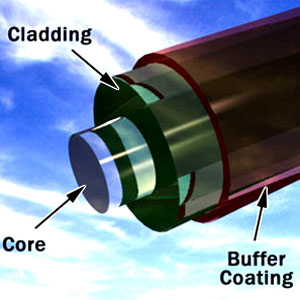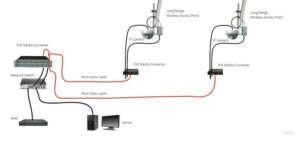When to Use Fibre Optic Cabling
 Using fibre optic cabling in a CCTV network is a contentious issue, and due to the perceived extra cost of fibre optic infrastructure, designers and specifiers need to have a robust argument for choosing this material. However, when you start to look into it, fibre optic transmission is often a far better option for a number of reasons.
Using fibre optic cabling in a CCTV network is a contentious issue, and due to the perceived extra cost of fibre optic infrastructure, designers and specifiers need to have a robust argument for choosing this material. However, when you start to look into it, fibre optic transmission is often a far better option for a number of reasons.
Longer distances
This is probably the most prominent reason for most specifiers choosing fibre, as the picture quality can be maintained over far greater distances than copper cable will achieve. Realistically, copper CAT5 cabling is only effective up to around 90m / 300ft, beyond which the picture becomes unusable. Fibre optic transmission can be extended to distances of 60km or more, making this the premium choice for sites where distant cameras are required on the network.
Multiple cameras
Because of the significantly improved bandwidth available with fibre optic cables, the ability to connect far more cameras into the feed is another major benefit. On systems where just one or two cameras are currently use, specifying fibre optic means the user can upgrade the system at a later date to support additional cameras without the hassle and expense of upgrading the infrastructure.
Higher quality picture
Because the fibre optic cables support a higher bandwidth and a faster data transfer speed, pictures can achieve a significantly higher resolution than that which is possible using coaxial or copper cabling. Added to this, fibre optic is non conductive and completely immune to radio frequency and electromagnetic interference therefore the picture can be relied upon to maintain its integrity no matter what is occurring in the neighbouring environment. Added to this, the system designer will have far greater flexibility of where to lay the cables and could even lash them to telephone lines without any interference being caused.
Data security and safety
Fibre optic cable is extremely difficult to tap, therefore is a perfect choice for organisations wishing to maintain the utmost security of their images along the line. In order to decode the images from the cable, the hacker would have to employ a good deal of specialist equipment and would have to be able to recognise not only the optical frequency but also the type of signal (AM/FM, digital, laser or LED) that is being transmitted.
Because all the information in the fibre optic cable is transmitted via photons, there is no risk of fire from the production of a spark, and the cables will not cause ground loops as copper cables have been known to. As previously mentioned, fibre is non conductive, so there is no risk of a lightning strike feeding back to the hub and causing fire or damage there.
Better reliability, reduced maintenance costs
Because the cabling is made from a mixture of sand, plastic, Kevlar and PVC there is very little which will degrade over time, so the potential to have to renew sections of the network in the next decade are highly unlikely. Added to this, the material is resistant to damp, chemical exposure and temperature changes, so can be buried underground or used in situations where other forms of cabling would not be up to the job.
Is fibre optic really more expensive?
Many users and systems designers presume that fibre optic cabling will be more expensive, but actually if you consider the whole life costing then it can work out similar or even better than other alternatives. The new, faster copper cabling such as CAT6 is more expensive and is coming close in terms of purchase price to that of fibre, and fibre is becoming cheaper by the day. Over time fibre is likely to continue to reduce in price as the raw materials for its manufacture (mainly sand) are far more freely available than copper.
Added to this, a system designed with fibre is future proofed in a number of ways. As well as the ability of the user to upgrade the system to support additional cameras, the fibre is capable of far faster transmission speeds than those which are currently employed in CCTV technology. As technology moves on, fibre optic cables will be able to grow and upgrade with the system, saving the user a good deal of money and trouble when wanting to upgrade.

How do I set up a CCTV camera on a fibre optic network?
Wan to know more about CCTV installation?
We regularly run CCTV Installation Courses. Check our CCTV installation courses here.
